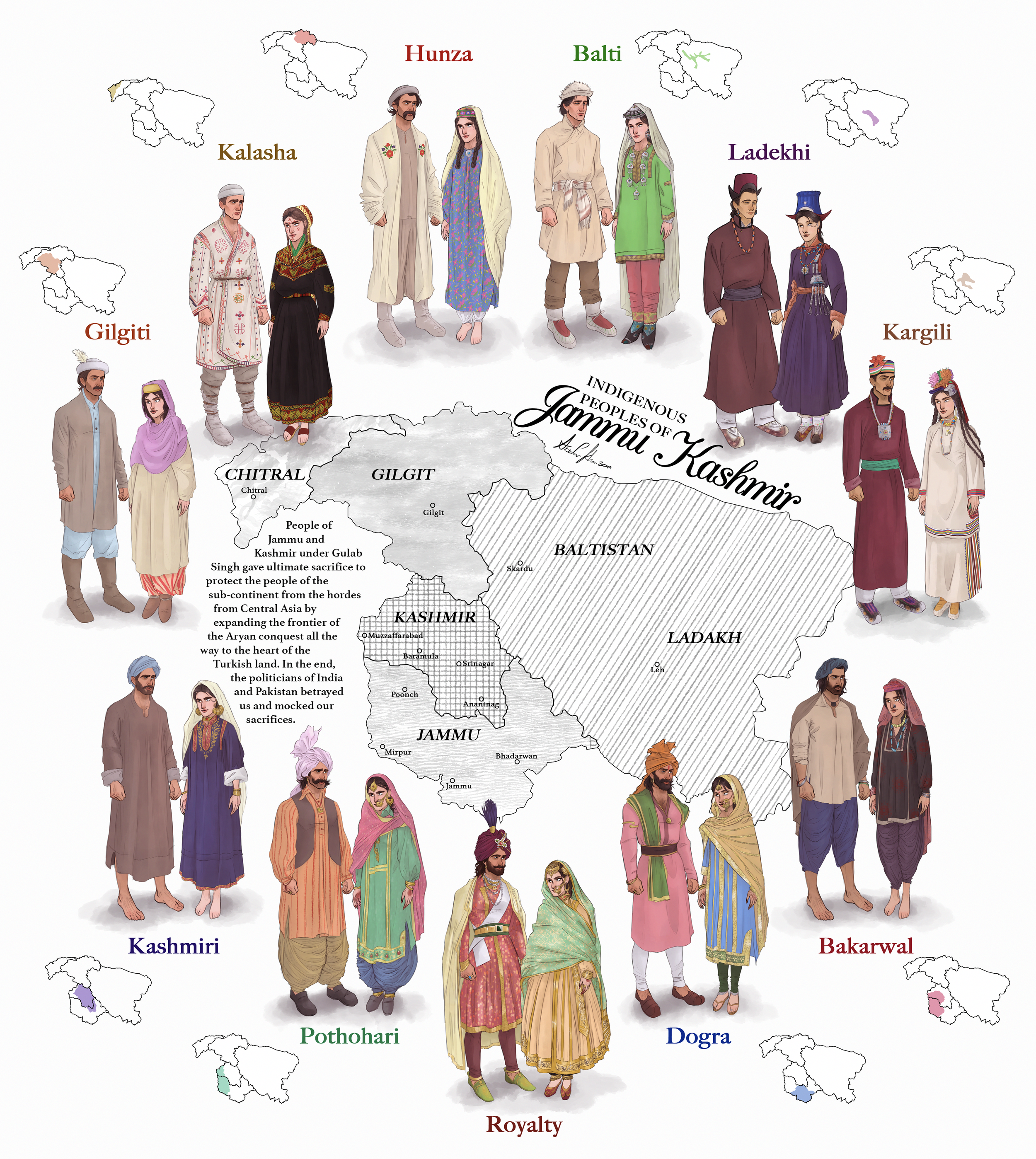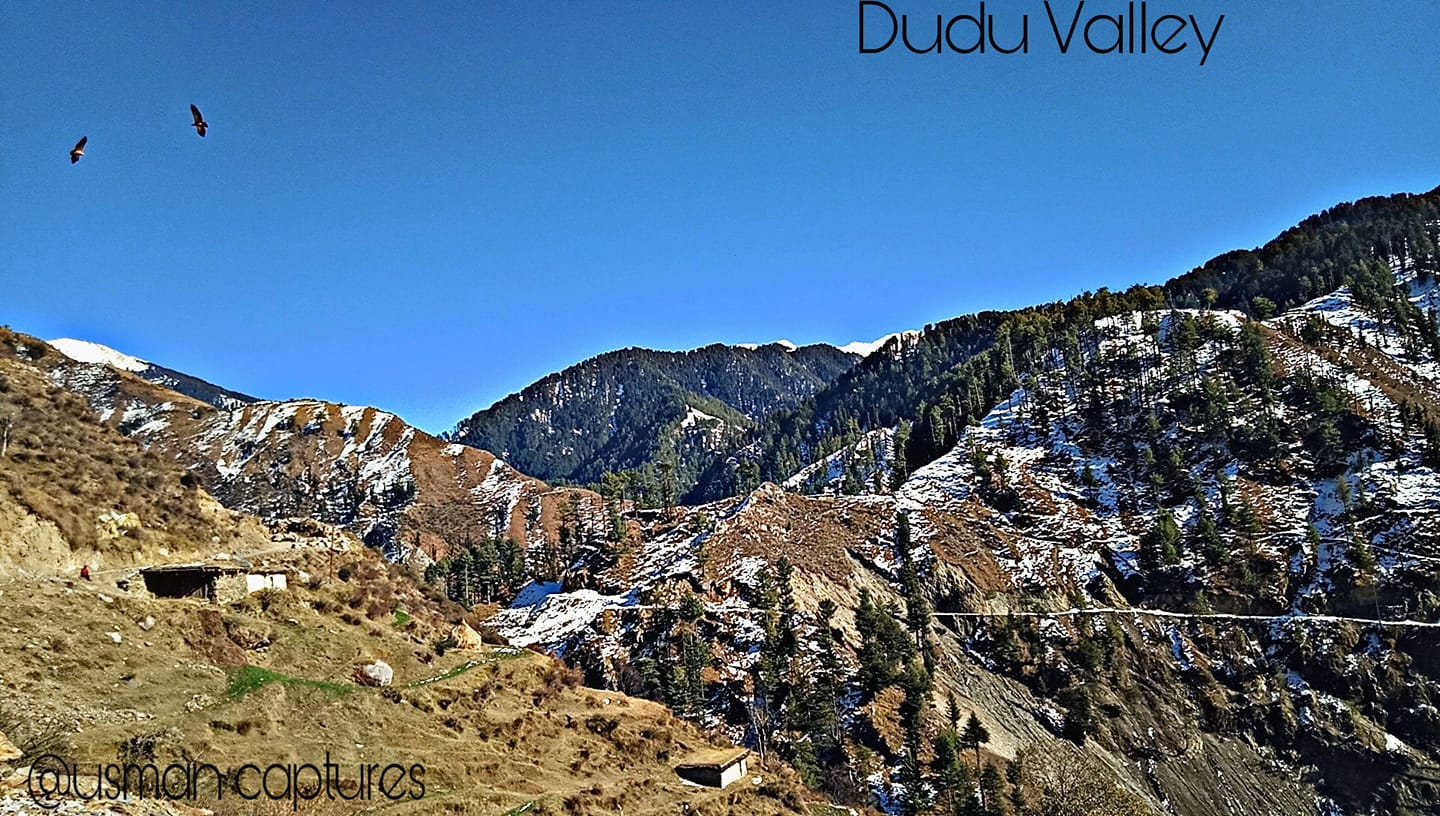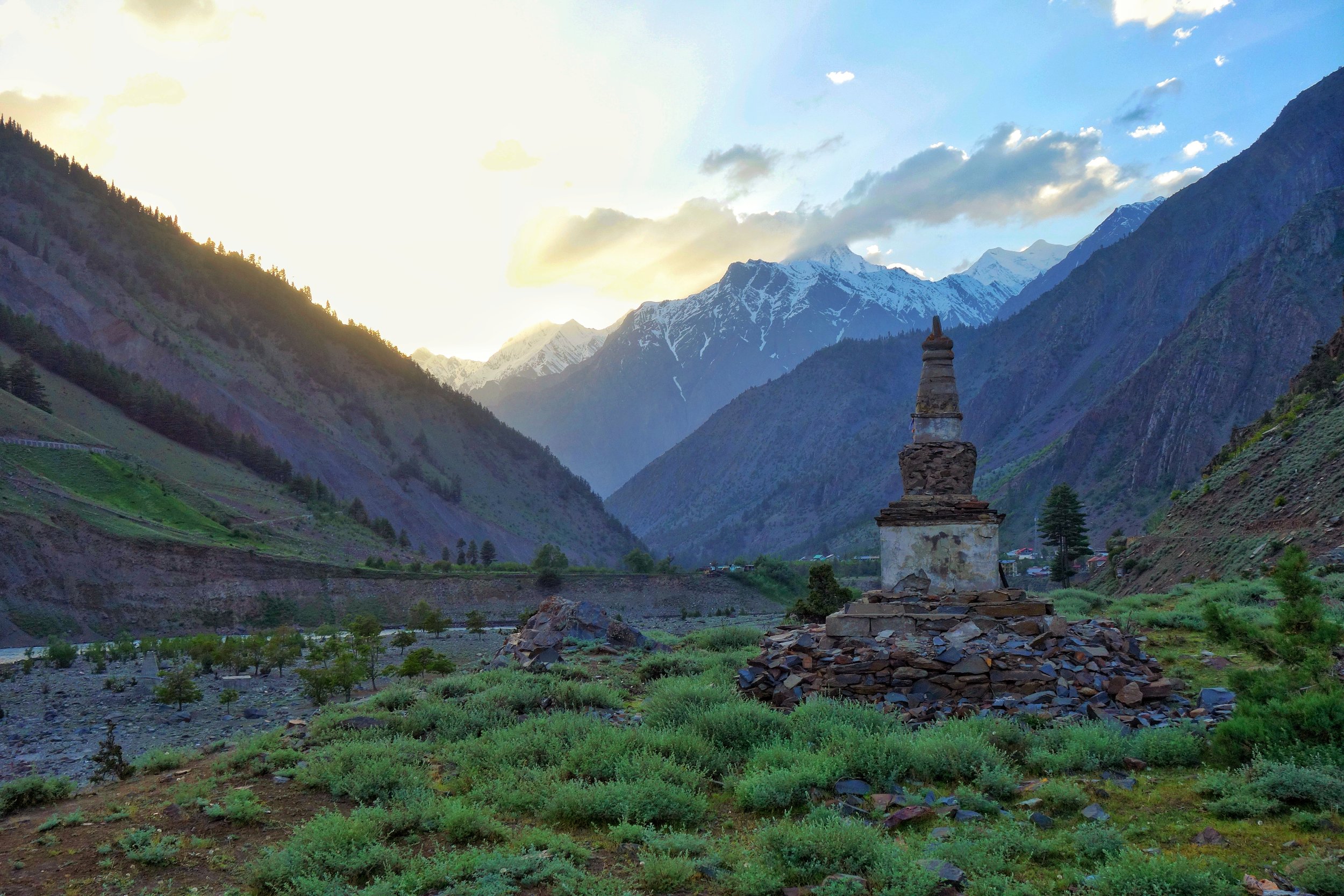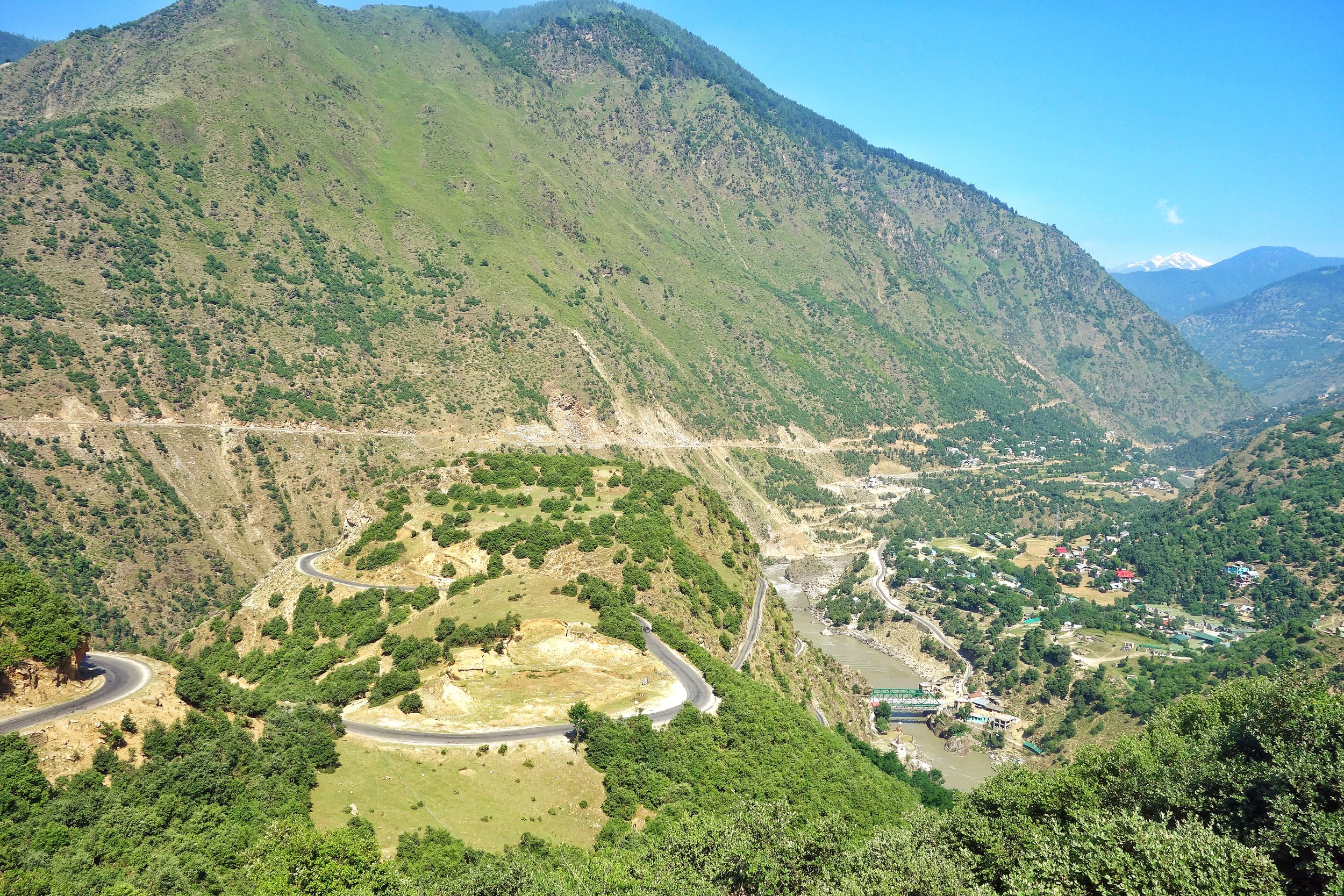Once upon a time there was an Englishman, called Pahadi Wilson who had crowned himself the Raja of Harsil so much so that he even issued his own currency, his own coin, for use in his own domain. Frederick E Wilson was his real name and his escapades could probably fill in a couple of Volumes. He was a Spy for the British Government and reportedly even had an affair with a Rani Sahib of Tehri it is said. And it is said that a curse was cast upon him and his coming generations by none other that Lord Shiva himself. Even the legendary Rudyard Kipling, who was a friend of his, described him as such, “lived a life that would have been the envy of kings”.
The Gilgit Game
Rakaposhi Peak as seen from the Gilgit Valley. Pic Courtesy Wikipedia
Gilgit, strategically located is a vast valley around the point where the Gilgit and Hunza River meet beyond the Great Himalayan Range .. It was bound from the North on one side by the Karakoram Range and on the Western side by the Hindu Kush. Its location particularly later in history was one of immense importance once the Great Game started between Tsarist Russia and Imperial Britain.
The Indigenous People of Jammu and Kashmir
The erstwhile State of Jammu and Kashmir was one of the most diverse State in the country in Ethnic, Religious and Lingual dimensions. The main "People" of Jammu and Kashmir and its different regions are briefly described in this Article.
The Dudu Timber Saga
A tale from a time gone by when Forests were seen as great Resources of Timber and vast tract of these Himalayan Forests were given out on contract for Timber extraction. My Family was also involved in this Timber trade and were known as others in this business at Forest Leasees. This particular story is from the remote and unknown Dudu Latti Valley in Udhampur District in the Jammu Division of the Union Territory of J&K.
The Dhankar Buddha of Spiti
The Dhankar Gompa in Spiti as among st its posessions a metal Statue of the Buddha which was off limits to outsiders. A few people had ever seen and it was first photographed for open sources only in 2010. This is the story of the Buddha which came all the way from Gilgit
The Chamba Lahaul and the British Lahaul Story
Lahaul and Spiti have had a checkered fascinating history and lying on the Himalayan borderlines they have always been the bone of contention for various powers in the Region from the states of Kashmir, Chamba, Kullu, Bushahr, Ladakh, Guge, Tibet, the Chinese and even the Mongols, Baltis and Yarkandis. However little is known of the exact circumstances and the chain of events of History that followed as there are no written records. All the above powerful states / people left some mark or influence on these two adjoining Regions. This is an attempt to piece together their History though for most of the time the History followed its separate course in Lahaul and its own course in Spiti.
And then there is Bhaderwah !
The beautiful Region of Bhaderwah in the Doda District of the Jammu and Kashmir really stands up as a rival to the beauty of the celebrated Kashmir Valley. nterestingly the Gazzetter of Kashmir and Ladakh of 1890 talks of this beautiful area as well. It specifically mentions that the fruits grown in Bhaderwah can rival the best grown in the Kashmir Valley. Tobacco grown in Bhaderwah at that time was said to be of a very superior quality. And Bhaderwah Homey was also said to be very good. In today’s age we know that the Bhaderwahi Rajmah is supposed to be one of the best Rajmah carrying on the old Bhaderwah tradition of being one of the finest agricultural areas in the State.
The Story of the Poonch Kingdom
Poonch is nowadays one of the most backward Districts of Jammu and Kashmir but it was once an important Hill Kingdom ruled by Rajput Hill Rajas, as was the norm in the lower Himalayas but over a period of time they had converted to Islam just like the Rajas of Kishtwar. The majority population of Poonch consists of Gujars and Bakarwals, along with Pahadis, Kashmiris, Punjabis, Rajputs and some Dogras.One feature which kinda unites the populace is that almost everyone speaks a version of Pahadi which is understood and spoken across the board. Traditionally Poonch has always been more of Punjabic / Potoharic (As in belonging to the Potohar Plateau) than Jammuic or Kashmiric.
Pogal Paristan : The Land of Fairies
There is a place called Pogal and Paristan/ sometimes written as Peristan as well. Pogal and Peristan are both Rivers and they together give their name to this area. As per some Paristan name is derived from the word “Pari” for fairy and hence it meant the Land of Fairies and it is really that beautiful from what I have read and seen. Sargali, Sunseri, GaganTop, Nandigarh, Hans Raj Peak, Sharvadhar and the beautiful Gugli Meadows are said to be some of the places worth visiting here. And the language spoken here is a seperate one called the Pogali which is considered close to Kishtwari and Kashmiri. But the fact that they have developed a dialect of their own speaks about the separate character of this Region.
Pandit Nain Singh Obituary by a British Officer
An Obituary of one of the Greatest “Pandits” of the Himalayan Exploration Saga, Pandit Nain Singh. The Pandits were a Group of local Pahadi people who were trained by the British to go and Explore neighbouring Mountain Regions which were off limits to the British.
The Lingual Diversity of the state of Jammu and Kashmir
The state of Jammu and Kashmir is made up of a number of geographically separate Regions divided by Ranges of the Himalaya. Its home to a diverse variety of Ethnicity, Cultures, Religions and of course Languages and Dialects. This article looks at the language diversity in the state of Jammu and Kashmir.
The Original Mountain Men and Women of the Western Himalayas
Ive had a childhood fascination for the Gujjars and especially the Bakarwals while growing up in Kashmir. Well they are almost the same thing except that nowadays the ones who live in fixed locations are called Gujjars while the ones which move up and down with their herds are referred to as the Bakarwals. Also as the name suggests it comes from the word Bakri, so a Bakarwal is also a keeper of the Sheep. Especially in the State of Jammu and Kashmir. There isnt a single Region in this vast State which is not familiar with the congenial Bakarwals who flocked to the highlands with their Goat/ Sheep / Buffaloes / Horses/ Mules which they term as “Maal” as in “Goods”. That is the commodity that they deal in and a Bakarwal is judged by the size of his Herd. And then there were my favourite part of a Bakarwal entourage, the Shepherd Dogs also called by the same name Bakarwal or Bakarwali.
The Dichotomy of the Moon River
The Moon River or the Chandrabhaga or the Chenab is a River that flows through some of the most rugged parts of the Himalayas starting its journey in the Lahaul Valley and making its way through Pangi Valley and into Padar Valley and Kishtwar in Jammu and Kashmir. It is a River of many legends and we try and Map its jurney from the Chandrabhaga to the Chenab.
The Pass of Shiva
The Pass of Shiva as it was originally called is one of the main Passes used since historical times and it connected Kashmir with Ladakh. A fascinating insight into the Pass of Shiva or the Sheoji Pass. Today this name has transformed into what we call the Zoji La.
The Sheep of Sinthan
The gentle Sheep of the Sinthan Pass which connects Kashmir with Kishtwar. An absolutely beautiful Pass with mind blowing scenery on either side.
Gurez to Drass
Gurez to Drass Road
A Road which connects Gurez to Drass via the Kaobal Gali. This provides an alternate Route from Kashmir into Ladakh via Gurez instead of the Zoji La but as of now the Road remains Off limits for Civilians and only Military Vehicles are allowed. Presenting some exclusive pics of this beautiful Road and hoping one day its opened for normal Civilian traffic.
The Minaret of Jam
Deep in the heart of the Koh-Baba Mountains which is one of the most westerly extension of the Hindu Kush Range, at an elevation of around 1900 m above sea level and at the confluence of the Hari Raud (Herat) and the Jam Rud Rivers lies a magnificent Monument. This Monument is a free standing Minaret and is the second highest free standing Minaret in the World. Second only to our very own Qutab Minar it actually was the inspiration for the Qutab Minar.
Of the Himalayan Mountains and Rivers
The Rivers and the Himalayas and the even the Mountain Ranges beyond it are always interacting in very interesting ways. In this article we see how the River Basins of the Indus, Ganges and Satluj and the Mountains interact and in some cases the River Basins extend beyond the Ranges themselves.
The Illustrated Mountain Geography of Ladakh
The mighty Nun Peak of the Great Himalayan Range at 7135 m its the highest Himalayan Peak in Jammu ans Kashmir (not including the areas under occupation). On the side is the Saddle Peak.
The Mountain Geography of Ladakh makes for interesting reading situated as it is between the Great Himalayan Range and the Karakoram Range. Also running within Ladakh are the Ladakh Range and the Zanskar Range but most people do not have a clear idea as to which Pass co-relates to which Pass.
The Exploration of the Siachen or Rose Glacier
The Siachen Map
The Story of the Exploration of the Siachen Glacier. This Glacier, now said to be the highest Battlefield in the World, was first Explored and Mapped by a team led by a Lady Fanny Bullock. This is her Story as well as Guide to explaining the Siachen Glacier with its main features and Glaciers around it.


















